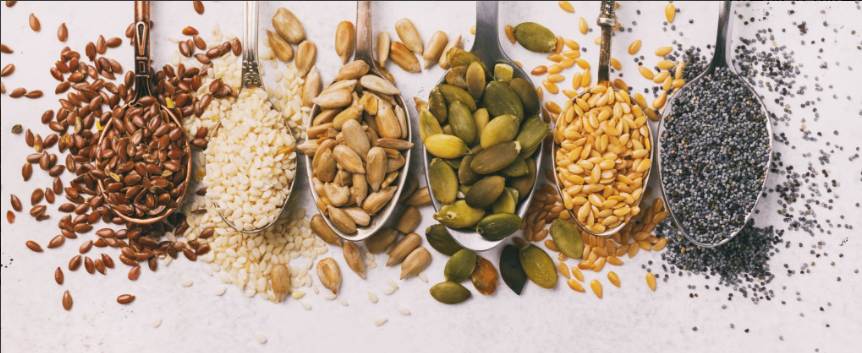What is seed cycling? Basically seed seed cycling is a practice when you eat specific seeds during two phases of your menstrual cycle. To begin with the follicular and luteal phases to promote a healthy balance of estrogen and progesterone levels. It’s a gentle and a natural way of reducing PMS symptoms, improve fertility and help simulate menstruation. It is also helpful with other symptoms such as hormonal imbalance. Beyond menstrual cycle post menopausal, seed cycling can be use at different stages of a women’s life. Understanding seed cycle better. There are two phases follicular phase begins the first day of your menstrual bleeding until the ovulation. Which typically last around 14 days. The second phase starts at ovulation until your next menstruation There is a rise in estrogen level during the first half of the cycle, and during the second half of the cycle progesterone level rise while estrogen level slowly decline. An imbalance between estrogen and progesterone can contribute to PMS symptoms, menstrual cramps, acne, short luteal phases and regular cycle. Seed cycling for fertility Moreover, seed cycling is based on the idea of influencing hormone levels through specific seeds, which may be beneficial for fertility. Flax seed in the first half of the cycle (follicular phase) may help regulate estrogen, promoting healthy follicle development for egg maturation. Pumpkin seeds in the second half (luteal phase) might support progesterone production. Which prepares the uterine lining for implantation. Balanced hormones are essential for various aspects of reproduction. Additionally, seeds like flax seed and sesame seeds contain anti-inflammatory properties, which might be helpful for fertility as inflammation can impact implantation. It’s important to note that while these potential benefits sound promising. More research is needed to confirm the effectiveness of seed cycling for improving fertility cycle. Seed cycling for PCOS Here the theory is that eating particular seeds at particular times. Throughout your menstrual cycle might affect your hormone levels. In the luteal phase of the cycle, which is the second half, pumpkin seeds may promote the synthesis of progesterone. While flax seed may aid in the regulation of estrogen in the follicular phase. Maintaining hormone balance is essential for controlling PCOS symptoms. How to incorporate Seed cycling is a straightforward practice to implement into one’s daily routine. The general guideline is to consume 1-2 tablespoons of the recommended seeds per day, either raw or ground up. These seeds can be easily incorporated into your normal diet in various ways – sprinkled on meals, mixed into yogurt or smoothies, or added to salad bowls. The specific seeds to eat depend on which phase of the menstrual cycle you are in, with flax and/or sesame seeds for the follicular phase, and pumpkin and/or sunflower seeds for the luteal phase. The flexibility in preparation and incorporation makes seed cycling a convenient and accessible practice to support hormonal balance throughout the monthly cycle. Nutrients you get from seed cycling Flax seeds : Rich in omega-3 fatty acids, fiber, and lignans (plant compounds with potential health benefits). Pumpkin seeds : A good source of zinc and magnesium. Sesame seeds: A good source of calcium, magnesium and healthy fats Sunflower seeds: A good source of vitamin E, selenium Conclusion In conclusion, seed cycling is a natural approach that involves consuming specific seeds during the different phases of the menstrual cycle to help promote hormonal balance. The theory behind it is that the nutrients in these seeds can support the rise and fall of estrogen and progesterone levels throughout the cycle. Seed cycling may offer potential benefits for managing PMS symptoms, regulating the menstrual cycle, and even improving fertility and PCOS symptoms. However, more research is still needed to conclusively confirm the effectiveness of this practice. Nonetheless, incorporating seed cycling can be a gentle and holistic way for women to support their reproductive health, as the seeds provide a variety of beneficial nutrients. As with any new health practice, it’s important to consult with a healthcare provider, especially for those with underlying medical conditions, to ensure it is suitable and safe for your individual needs.
Category: health
Low calorie food: successfully following the lifestyle
Low calorie food Many individuals resort to low calorie food in an effort to get thinner. The day-to-day calorie admission is restricted to 1200–1500 for ladies and 1500–1800 for guys. Thus, there is a calorie shortage because your body removes a larger number of calories than it consumes. Natural food varieties like organic products, vegetables, and lean protein sources are needed in low-calorie foods. These control your calorie consumption while maintaining a sense of completion and fulfilment. Finding a well-rounded strategy that emphasizes nutrient-dense. Whole meals and includes techniques like strength training to reduce. Muscle loss and increase metabolism is important. Recall that losing weight is a journey, and for long-term success, a sustained, moderate-calorie diet together with regular exercise is frequently advised. Low calorie food: science behind it Calorie Deficit: a calorie shortfall is the point at which your body ousts a bigger number of calories than it consumes. Your body involves the put away fat as fuel because of this deficiency, which causes weight reduction. Metabolic Rate: Your body uses your metabolic rate, which is like its engine’s output, to continuously burn calories to power all of your activities. This may be measured in two primary ways: While resting metabolic rate (RMR) is comparable but may include some activity, basal metabolic rate (BMR) is the minimal number of calories required for basic operations while at rest. Because muscle burns more calories than fat even while at rest, muscular mass is important. Understanding your metabolic rate is helpful in managing your weight since weight gain results from ingesting more calories than you burn, and vice versa. Types of Low calorie Diets: Traditional Low-Calorie Diet (LCD): For ladies, this implies ingesting 1200-1500 calories each day, and for guys, 1500-1800 calories each day. It underlines entire, natural food sources like entire grains, organic products, vegetables, and lean protein. Very Low-Calorie Diet (VLCD): This is a stricter diet that typically involves medical supervision and calls for 800-1000 calories per day. To guarantee enough nutrition, it could entail meal substitutes. Benefits: Effective Weight Loss: Low calorie food can lead to significant weight, especially initially. Studies show they can be as effective as other approaches in the short term. Improved Health Markers: losing weight following calorie deficit can affect your health in many ways like lowering your blood pressure, cholesterol levels, blood sugar control and reducing the risk of chronic diseases like diabetes and heart disease. Potential challenges while doing calorie deficit: Nutrient Deficiencies: Consuming low calorie food makes it harder to get all the nutrients you need. It would consist of a range of meals low in nutrients. It’s important to think about supplements under a doctor’s supervision. Supplements provide you with the essential quantity, which is insufficient for what we obtain from our diets. Muscle Loss: One of the major challenges you face with calorie deficit is you tend to lose a lot of muscle during this process. It is crucial to incorporate weight training along and maintaining metabolism. Sustainability: Maintain long-term strict low calorie food can be difficult to follow. Finding a healthy, balanced approach you can stick with everyday. Maximizing Success: Doctor Consultation: Discuss any goals you have in mind and any underlying health conditions with your doctor before you consider following the low calorie diet. Registered Dietician: Customizing your diet including meeting your daily caloric requirements and satisfying your chosen taste buds. You can also choose to eat exclusively vegetarian or entirely non-vegetarian meals, or a combination of the two making it a perfect combination of low calorie food. Focus on Whole Foods: Incorporate more fruits, vegetables, lean protein, and whole grains to feel full and satisfied while keeping calorie intake low. Mindful Eating: Observe your body’s signals of hunger and fullness. Take your time and enjoy your meal to prevent overindulging. Water Drinking plenty of water keeps you fuller which can curb your cravings. Physical activity: Regular exercising can aid weight loss and overall health. Conclusion Consumption of low calorie food shouldn’t be a crash course, despite the allure of rapid results. It functions by causing an imbalance in which your body is forced to burn more calories than it takes in, causing it to turn to stored fat as fuel. This translates to losing weight, but it’s imperative to do so under a doctor’s supervision. For your specific requirements, they can assist in establishing a deficit that is both safe and sustainable.Recall that losing weight in a healthy way is a marathon, not a sprint. In order to maintain a sustainable calorie deficit and feel satisfied and fed, concentrate on packing your plate with nutritious foods. You’ll be on the road to long-term success after following it successfully. Written By:- Amisha
Top 4 Benefits of Flax Seed and how it can be used on daily basis
Benefits of flax seed Linseed, another name for flax seed, is a super food full of nutrients. These little seeds are rich in lignans, omega-3 fatty acids, and fibre, all of which have a number of positive effects on health. Let’s examine possible health benefits of flax seed and how to include it in your diet in more detail. Benefits of flax seed Consuming 4-5 tablespoons of flax seed can bring about a lot of changes in your life. Let’s understand the benefits of using this tiny seed. Digestive health Both soluble and insoluble fiber might be tracked down in overflow in flax seed. While insoluble fiber assists with routineness and simple absorption. Soluble fiber upholds great stomach verdure and assists you with feeling more full for longer. Heart health Another benefit of flax seed is it contains an omega-3 unsaturated fat called alpha-linolenic corrosive (ALA), which might assist with bringing down awful cholesterol (LDL) and lessen irritation, consequently decreasing the gamble of coronary illness. Blood Sugar Control Flax seed fibres slow down the absorption of carbs, which may help control blood sugar. Those who have prediabetes or type 2 diabetes may benefit from this. Cancer Risk Reduction: Studies indicate that flax seed’s lignans may possess anti-tumorogenic qualities. Certain cancers, like prostate and breast cancer, may be prevented by certain plant chemicals. How to Use Flax seed: Popularly linseed is one more name for flax seed, high supplements make it a superfood. Flax seed are rich in lignans, omega-3 unsaturated fats, and fiber, all of which have various beneficial outcomes on wellbeing. We should comprehend the medical advantages of flax seed and how might you remember them something else for your eating regimen. Here are an different ways of remembering how flax seed can be incorporated in your daily meals easily: Sprinkle it over yogurt parfaits, mixed greens, cooked vegetables, and smoothies; prepare it into biscuit, treat, and bread recipes; or use it as a vegetarian egg substitute by consolidating one tablespoon ground flax seed with three tablespoons water and allowing it to sit until it gels. Things to remember Even thought there are a lot of benefits of flax seed, there are certain things to remember while using them. Because flax seed contains a lot of fibre, increase your consumption gradually to prevent gas and bloating. Grinding the seed is advised since whole flax seed poses a choking hazard, particularly for young children. Because ground flax seed contains a lot of oil, its shelf life is shortened. For optimal freshness, keep it refrigerated in an airtight container. Conclusion In conclusion, flax seed is a flexible and supplement-rich addition to most weight-control plans. Its high fiber content advances stomach-related wellbeing, while the omega-3 unsaturated fats and lignans offer expected benefits for heart health, glucose control, and even disease risk reduction. By integrating flax seed into your day-to-day daily schedule through smoothies, prepared products, or sprinkles on dishes, you can undoubtedly reap the advantages of flax seed for a better you. Keep in mind that you should counsel an expert prior to rolling out significant dietary improvements; however, flax seed could be a straightforward step towards a more adjusted and balanced diet. Written By:- Amisha




